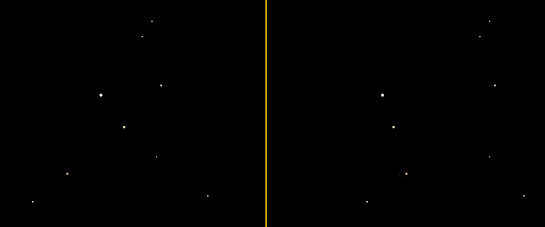When we look out into the universe from Earth, from within our Milky Way galaxy, we are looking through a lot of static. This static is all the stars, clusters, nebulae, and dust in our own galaxy. When we look outward through the plane of the galaxy we see more static (the Milky Way in our night sky), somewhat less when we look above or below the plane.
Look at any image of a galaxy and you’ll see lots of stars. But except for some high-powered images of very close galaxies, these are all Milky Way stars just getting in the way. Sure,
it makes a pretty picture, but the reality of it is that we are looking at a very distant object, the galaxy, through a screen of very close objects, all of the Milky Way stars and objects.
At outreach events, I try to give people a sense of this by describing it as looking out of a car windshield in the rain at another car way down the road. The raindrops on the windshield
are the stars in our own galaxy, and the car is another galaxy.
If we took away all the foreground stars and objects—wiping the windshield, as it were—we would get a better picture of what specific galaxies look like from intergalactic space. When looking in a telescope, foreground stars often distort the view of the faint galaxy and we even get used to foreground star patterns as if they are part
of the galaxy. But they aren’t.
This is just another way of looking at our universe from a different perspective. In this case, a perspective we will never have the chance to actually experience. But we can simulate that
experience as if we were in an intergalactic spacecraft, traveling through the universe as we pass galaxy after galaxy. There isn’t a whole lot of anything visible between galaxies. We might pass the occasional intergalactic star close enough to see it, but mostly we would be passing
through very rarified ionized hydrogen gas with some other elements thrown in—essentially a pristine view through a clean windshield.
Here are some examples of what we might see from the window of our intergalactic spacecraft:
M31, The Andromeda Galaxy
At 2.5 million light years from Earth, M31 is a member of our local group of galaxies. Larger telescopes can make out several dust lanes, many of the galaxy’s globular clusters, as
well as larger nebulae. It has two satellite galaxies, M32 (above) and M110 (below), seen in these images with south up.
The view through the stars in our own galaxy:
Our view from intergalactic space:
Photo of M31 by Hypatia Alexandria (CC). Starless version created with StarNet.
NGC 2403
Farther away at 8 million light years is the spiral galaxy NGC 2403. The galaxy is about 50,000 light years in diameter. It contains a huge HII star-forming region, NGC 2404, almost 1,000
light years in diameter itself, visible as a pink spot on the right side of the center of the galaxy in this image with south up. Notice the distant galaxy in the upper left.
The view through the stars in our own galaxy:
Our view from intergalactic space:

Photo of NGC 2403 by Carsten Frenzl (CC). Starless version created with StarNet.
NGC 4038 and 4039 (The Antennae)
NGC 4038 and 4039 are colliding and merging galaxies also known as The Antennae or Ring Tail Galaxies (ARP 244). The tidal tails looking like insect antennae are a result of this interaction,
and can be seen better without the intervening Milky Way star screen. The galaxies are about 45 million light years away.
The view through the stars in our own galaxy:
Our view from intergalactic space:
Photo of Antennae galaxies by Nicholas Jones (CC). Starless version created with StarNet and Paint.net.
Supernova in M101
One of the few times we can ever see a star in another galaxy in our backyard telescopes is when it explodes as a supernova, sometimes outshining its entire galaxy. The images below show the recent Supernova 2023ixf in one of the outer arms of the large spiral galaxy M101, 21 million light years away. The supernova is below and left of the center of the galaxy, apparently embedded in the HII region NGC 5461. The detached blue spot to the left of the galaxy is NGC 5471, a massive star-forming HII region in its outer arm, about 200 times the size of the Orion Nebula, M42. That's a distant galaxy, PGC 49919 at about 100 million light years distant, on the right edge of the image.
The view through the stars in our own galaxy:
Our view from intergalactic space:
Photo of M101 and SN2023ixf by Jason Allread (CC). Starless version created with StarNet and Paint.net.















_(45192016582).jpg)


































